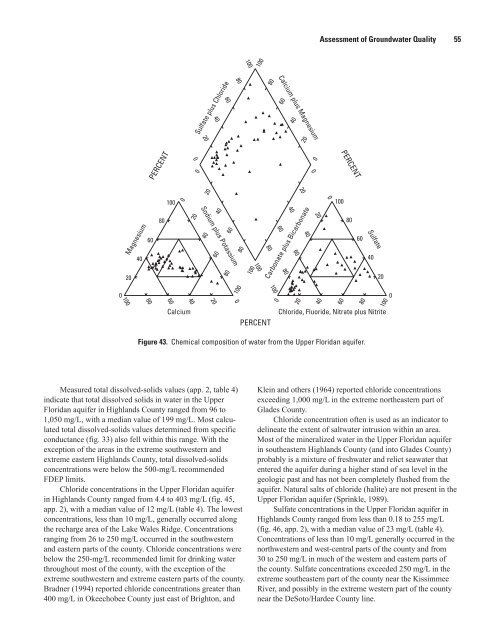Hydrogeology and Groundwater Quality of Highlands ... - USGS
Hydrogeology and Groundwater Quality of Highlands ... - USGS
Hydrogeology and Groundwater Quality of Highlands ... - USGS
You also want an ePaper? Increase the reach of your titles
YUMPU automatically turns print PDFs into web optimized ePapers that Google loves.
0<br />
100<br />
20<br />
Magnesium<br />
40<br />
Measured total dissolved-solids values (app. 2, table 4)<br />
indicate that total dissolved solids in water in the Upper<br />
Floridan aquifer in Highl<strong>and</strong>s County ranged from 96 to<br />
1,050 mg/L, with a median value <strong>of</strong> 199 mg/L. Most calculated<br />
total dissolved-solids values determined from specific<br />
conductance (fig. 33) also fell within this range. With the<br />
exception <strong>of</strong> the areas in the extreme southwestern <strong>and</strong><br />
extreme eastern Highl<strong>and</strong>s County, total dissolved-solids<br />
concentrations were below the 500-mg/L recommended<br />
FDEP limits.<br />
Chloride concentrations in the Upper Floridan aquifer<br />
in Highl<strong>and</strong>s County ranged from 4.4 to 403 mg/L (fig. 45,<br />
app. 2), with a median value <strong>of</strong> 12 mg/L (table 4). The lowest<br />
concentrations, less than 10 mg/L, generally occurred along<br />
the recharge area <strong>of</strong> the Lake Wales Ridge. Concentrations<br />
ranging from 26 to 250 mg/L occurred in the southwestern<br />
<strong>and</strong> eastern parts <strong>of</strong> the county. Chloride concentrations were<br />
below the 250-mg/L recommended limit for drinking water<br />
throughout most <strong>of</strong> the county, with the exception <strong>of</strong> the<br />
extreme southwestern <strong>and</strong> extreme eastern parts <strong>of</strong> the county.<br />
Bradner (1994) reported chloride concentrations greater than<br />
400 mg/L in Okeechobee County just east <strong>of</strong> Brighton, <strong>and</strong><br />
80<br />
60<br />
PERCENT<br />
80<br />
100 0<br />
60<br />
40<br />
Calcium<br />
0<br />
20<br />
0<br />
Sulfate plus Chloride<br />
20<br />
20<br />
40<br />
60<br />
20<br />
40<br />
Sodium plus Potassium<br />
40<br />
60<br />
60<br />
80<br />
100<br />
0<br />
80<br />
80<br />
100<br />
100<br />
100<br />
100<br />
80<br />
80<br />
PERCENT<br />
100<br />
0<br />
Calcium plus Magnesium<br />
60<br />
60<br />
80<br />
40<br />
40<br />
60<br />
20<br />
20<br />
20<br />
40<br />
Carbonate plus Bicarbonate<br />
0<br />
0<br />
20<br />
40<br />
Assessment <strong>of</strong> <strong>Groundwater</strong> <strong>Quality</strong> 55<br />
0<br />
100<br />
60<br />
PERCENT<br />
80<br />
60<br />
80<br />
Sulfate<br />
Klein <strong>and</strong> others (1964) reported chloride concentrations<br />
exceeding 1,000 mg/L in the extreme northeastern part <strong>of</strong><br />
Glades County.<br />
Chloride concentration <strong>of</strong>ten is used as an indicator to<br />
delineate the extent <strong>of</strong> saltwater intrusion within an area.<br />
Most <strong>of</strong> the mineralized water in the Upper Floridan aquifer<br />
in southeastern Highl<strong>and</strong>s County (<strong>and</strong> into Glades County)<br />
probably is a mixture <strong>of</strong> freshwater <strong>and</strong> relict seawater that<br />
entered the aquifer during a higher st<strong>and</strong> <strong>of</strong> sea level in the<br />
geologic past <strong>and</strong> has not been completely flushed from the<br />
aquifer. Natural salts <strong>of</strong> chloride (halite) are not present in the<br />
Upper Floridan aquifer (Sprinkle, 1989).<br />
Sulfate concentrations in the Upper Floridan aquifer in<br />
Highl<strong>and</strong>s County ranged from less than 0.18 to 255 mg/L<br />
(fig. 46, app. 2), with a median value <strong>of</strong> 23 mg/L (table 4).<br />
Concentrations <strong>of</strong> less than 10 mg/L generally occurred in the<br />
northwestern <strong>and</strong> west-central parts <strong>of</strong> the county <strong>and</strong> from<br />
30 to 250 mg/L in much <strong>of</strong> the western <strong>and</strong> eastern parts <strong>of</strong><br />
the county. Sulfate concentrations exceeded 250 mg/L in the<br />
extreme southeastern part <strong>of</strong> the county near the Kissimmee<br />
River, <strong>and</strong> possibly in the extreme western part <strong>of</strong> the county<br />
near the DeSoto/Hardee County line.<br />
40<br />
20<br />
100<br />
Chloride, Fluoride, Nitrate plus Nitrite<br />
Figure 43. Chemical composition <strong>of</strong> water from the Upper Floridan aquifer.<br />
0

















